#substructure
Explore tagged Tumblr posts
Text

its two months till june but wk has me by the throat i had no choice im sorry. this is like the best person-shaped thing i’ve drawn ever i don’t know how i feel
47 notes
·
View notes
Text


Now for a minerally-type worldbuilding post! There is this type of material with two different names depending on what era we're talking about. In Ancient times it's called "Godsblood", its related to granite and is very strong material used for buildings, statues, etc. It has a pattern similar to marble, and the overall color ranges from smoky gray, to green-gray, to a deep, saturated green. There are also two variations - a "normal" type and one with unusual swirling veins intruding through the normal pattern. This vein shines a rust or reddish color when the light hits it, and singular swirls are also very large ~ averaging several feet across.
What is notable about this is where it cones from - Due to the nature of The Beacon being primarily underground, Aki has to constantly mine himself out to make more room to build stuff. One of the materials getting mined out is Godsblood - for the most part it is the normal variant but a certain percentage of it has the swirls. The material is desirable - for the most part it goes right back into The Beacon’s buildings but Aki does allow some of it to be sold off with the funds going into the city's treasury for public works, etc. Outside of the Beacon, the swirl variant is most commonly used in temples, shrines, and art/sculpture.
I have attempted to edit some stock photos from pexels so you have an idea of what's going on (The scale of the veined pieces should actually be even bigger but. you get the idea)


In modern day this same material is called "Ironeyes" and the name is exclusively referring to the variant with the swirls. It's pretty rare, some specimens are in museums and such but the majority are in private collections or in the black market. Nobody can figure out where it actually came from and they probably won't ever, because what they have is what was shifted over from the plane split. The Beacon doesn't exist in current Reality, they'd only find the normal variant in the same location.
Now, back to Ancient times, a similar phenomenon does occur at the other cities, but with different materials and not at this scale. For example, Haven has a ton of trees growing on and around it. If you were to split them you would see some unusual patterns in the wood and some trees would also have similar looking veins running through them. However, Kanta prefers sourcing wood elsewhere instead of logging their own trees, so you don't see as much of that.
#behold! my art#my art#worldbuilding#Location: Fatewinder's Beacon#Worldbuilding: Stuff#Fantasy rocks#sentient cities#oh and I haven't even gotten into the correct aesthetic for The Beacon....which is heavily art deco with some other stuff mixed#so please just envision this color on top of art deco#I have engineered The Beacon to have been exceedingly beautiful in it's day and then just kind of horrific in modern day#b/c it's a pitch black pit with buildings and ultimately thousands of rooms and substructures that go on for miles and miles#with the bonus of these veins that shine differently from the rest of the rock around them when you use a flashlight
6 notes
·
View notes
Text

[Substructures.]
7 notes
·
View notes
Text

"substructure"
<3
3K notes
·
View notes
Text
relevance logic gives up nice properties in order to make logic less funny. what a waste…
1 note
·
View note
Text
Well there is a ttrpg project I have been working on, HISTORIC: The Road Eternal
Let’s be straightforward.


“On this burnt and blackened world, an annihilating sun scorches the world above as burning, oil dripping angelic machines known as Aeons whirl overhead in the skies. The Ensu live beneath the surface in their Barrow Cities, meandering throughout the world's substructures. They have for generations done their best to avoid the Aeons in the sky, or the cruel, hungering Malefact who make their meat-hives near the surface and deep in the caves…”
Choose your character there


The caged wraith & the organ eater


Maker of hands & Malefact Bonecutter


Aeon caller & Trophy collector
The project page if you interested
#ttrpg#indie ttrpg#fantasy#illustration#rodent#dungeons and dragons#dnd#I don’t know I’m just going with random tags at the moment#it’s aa lot of rodents I will share more
535 notes
·
View notes
Text
Stoker's book was ending up quite unlike the lurid sensation novel he had first envisioned. In making his final revisions, he fell back instinctively, if perhaps unconsciously, on the sturdy substructure of the litary form that had sustained him since childhood: the fairy tale. The plot took on an archetypal simplicity, drawing on the folktale motif of abused and abandoned children. An orphan (Jonathan Harker, bereft of parentage like most of the main characters) ventures into the woods and is confronted with a terrifying demon king, who chases him home, but the young hero must return to the dreaded place to destroy the monster and restore moral order. Among the many calssic tales evoked are "Bluebeard" (the castle with locked rooms and bloody secrets), "Jack the Giant Killer" (the ogre who chases the protagonist to his homeland and is slain), and "Little Red Riding Hood" (explicitly cited in Stoker's text and mimicked when a wolf crashes through a bedroom window to menace Lucy and her mother). In short, for Dracula to be saved as a publishable tale, it had to be shrunken, collapsed, and dwindled down into a bedtime story of childhood abandonment and rescue.
david j. skal, something in the blood: the untold story of bram stoker, the man who wrote dracula
#i don't agree with all of skal's takes (and in fact right after this he approvingly cites another scholar characterizing the cast as#having arrested development & being incapable of growing up... insane read and rly in need of some Unpacking Unarticulated Values)#but i looooove the reading of dracula as a fairy tale...#dracula daily#something in the blood#media 2k24
182 notes
·
View notes
Text
COME TOUCH ME TOO | Best friend’s dad
age gap. 11.2K on patreon

second part to LIQUID SMOOTH
You’d catch him over the sink sometimes. Or the stove. At the dinette, shirtless. Big bear, you thought, still only half-awake (starving), staring at his skin, swathed in ink that traversed limb, to torso, to limb. You’d catch the smattering of dark hair pooling over his sternum, and the hair beneath his navel, darker, more wiry, seeping into the band of his pajama pants. And later, you’d wonder if it was the substructure— torn out from you— that you were chasing (the surfeited rift between your ages, the sage wisdom you lacked), or if it was just the shape of him, the way he fit into your life, the subtle domesticity of a morning. The pantomime of a distant daydream. (Pretending this was your life you were living, and not taking a page from someone else’s.)
preview
The bar you’re at feels congested. Sticky, shoulders brushing shoulders, feet bumping feet, and the music is loud enough that you feel it droning along the skin of your bones. Past max-capacity; something you anticipated. Accepted on a Friday night— no sort of discomfort that couldn’t be waterlogged into an unconcerned bliss with enough alcohol.
And that’s what it started as.
One shot to ease the restless hypervigilance (when you shuffled in, sliding between clusters of bodies), that burned at the back of your throat, heat flaring across your crinkling sinuses. Then, a second, that radiated warmth along your chest, under your skin, that settled as a weightless feeling beneath the soles of your feet. Loosened the arc of your shoulders.
(You never buy your own drinks.)
A third, cupped from a stranger’s fingers, with bright, powder blue eyes that lingered on your throat, the line of your jaw when you tipped your head back. Inkpools stuck to your tongue when you smeared it out across your lips, the bridge of your nose rucking. He gave you a wolfish, glimmering grin and told you what a pretty thing you are.
(And you think, staring up at him through the misting crest of intoxicant smog, he’s too young. Feels like a boy— one you can’t re-mold even in the haze of alcohol— in the absence of crows’ feet and shallow smile lines, the glinting, tawdry rhinestone stuck to his incisor. Skin speckled with ink that resembles zealous impulse rather than an aged, carefully-crafted tapestry. You doubt there’s any worthwhile story behind the dice in the nook of his elbow; RICH across the front, C and H tipped perfectly on their southern edges to show the S and K that could fill the word out, instead.)
(You can’t even pretend.)
You seldom find regret in the sea of a familiar gyre (the world spinning, and you, finally, spinning with it), but the spindrift crashes across in a misty fog of discomfort. The riptide lures you out to swallow you whole. You’re not sure when the euphoria mutates into anxiety— maybe somewhere along the fourth and the fifth— but it coagulates in your esophagus, in your stomach. Cakes in the warm, soft spot under your ribcage, until your bones feel like they’re wobbling with the pulse of your heart. Vibrating.
You showed up with a coworker. Admittedly, one you didn’t know too well, to a bar you haven’t been to before. But going out is going out, and a bar is a bar. You don’t need a babysitter, you don’t need to know her well, and you don’t need to scope the the pub, but—
Last you saw her, she was propped against the corner of the bar, and now, as you sweep your bleary gaze over the mass, she’s nowhere in sight. You’re alone. You’re alone, and the world is spinning, screaming, chattering over the pulsing base, and you feel like you can’t keep up.
When you swallow, it lodges in your throat. You feel like you can’t breathe, nearly tripping over your own feet, brushing between tangled musculature, limbs like gnarled, warm roots for you stumble over. And you feel like you’re trying to part the sea to make room for your clumsy steps. Like you’re trying to move mountains.
By the time you make it outside, your lungs are aching, and your shoulders are quaking. You don’t know where it’s coming from— what it is— but it feels like a flame licking its way up under your dermis, and you want to shed your skin off the bone. The gulp of air you take is welcome. Cold. Wet.
It’s raining.
Pouring. The gust drenches your bare legs in spittle off the sky, even under the awning. Helplessly, you pat around for your phone.
And you don’t know what possesses you. You don’t know if it’s a clumsy swipe of your thumb across the glowing screen, or a cruel form of divine intervention, when you scroll and stutter along his contact. It’s a number you should’ve deleted. Haven’t pressed in months.
You flung yourself out of orbit, and seeing his name feels like you’re a piece of star-shed that’s slipped too close— a hair from homecoming. It feels like the inevitable, crushing weight of gravity snagging you into the miserable ouroboros you’ve spent every evening running from. A tidal wave, reborn, swallowing you whole.
And you know the repercussions— the potential there. The consequences of sticking wet fingers into electrical sockets, but you tell yourself, he won’t pick up. It’s too late. You’re too late. Too—
Your finger lingers.
You don’t know what would be worse. Abandonment in another shape, or hearing his voice on the other end of the line.
You call him.
You regret it a split-second too late, staring down at the screen dialing. When you press the phone to your ear, with the rain spitting, the thrum of the bass behind the door— your heart rattling in your ears, your head spinning—
You barely hear the three rings before the line clicks. It’s quiet.
And then—
“Hello?”
You suck in a gust of air. You expected his voice to hurt. To ache— you anticipated, maybe, a lot of things, with variegated hypotheticals spelled out in misty shapes through hours spent staring at your ceiling.
But every chimera crumbles when the words stick to the back of your throat. Part of it is the slurry in your veins, the hard liquor, the way it’s all kicked in, all at once. And part of it is the realization that, despite the biramous conjectures you’ve crafted— the what if’s— it’s the heavy thought that all roads lead to this.
He sounds hoarse. Mean with sleep.
“Um. Hi.” The words sound garbled, like you’re underwater. Tinny, wet, strained.
Eager in the shape of unrequited pining; a mangled fruition of all the nights you’d spent, thumb hovering over the call button, wondering if he’d pick up on the other end of the line, stockpiling the heap of broken wishes. The ones you cradled in your hands like jagged fractures of your rib bones, cracked from how hard your heart was pounding.
(If only he could see the lovelorn tar in your marrow, leaking out in a rotting treacle and pooling in the crevice of your love-line; tragic, broken down a long gap right under the wedge between your pinky and ring finger.)
The awning does a poor job of covering your toes, and they soak in the torrent that spumes from the midnight aether, shimmering against the wet asphalt. Silly, little girl— woman, nowadays— one ear corked with your forefinger to stifle the downpour spitting from the same sky you’d crane your neck and spill orisons at, the other fisting at your phone like a lifeline. Dangling onto the thread off this unspooled hope.
You sound ditzy. Soporific. Lost. You wonder if he picks up on it on the other end of the line. “Are you, um. Are you busy?”
The speaker crackles.
Finally, he rasps from the other end of the line— a thunderclap, like a gunshot, “You’re not callin’ me at one in the morning to ask me if I’m busy.”
“I—“ the words stick to the back of your throat.
Something seals up in your lungs with the breath you try to take.
Bitter recrudesce, a reminder when it wakes back up in the slotted teeth of your heart— an ache, alleviated in his absence after time, that throbs at the sound of his voice. Your jaw quakes on what you want to confess, snarled in your throat. I love you— Please— I’ve loved you since—
Your lip wobbles. Teeth clack, staring at the wet asphalt. “Uh. Sorry.”
You settle for a middle ground— some compromise in the clouded welter of your docket— something you’ve been meaning to say for months.
(Sorry for being a silly, little girl that fell in love with you.)
You’re met with a beat of silence that eats into your marrow. Has your guts twisting, chest tight. Then, (solace) a sigh— surly— oozes across the crackling speaker.
“Where are you?”
The question reminds you why you called in the first place. That you’re sopping up dirty rainwater with your boots on the outskirts of town, outside some seedy bar you came to, to drown your demons (him) in burnt amber. A thunderbolt ripples across the pitch aether, zagging electric chalky across the swollen plumes. All at once, you…
Crumble.
“I’m, um. Ah…” your chin quivers. You nod, “I’m here. At a, um. At a bar. Outside a bar.”
“Which bar? Who are you with?”
The slew of questions nearly makes you laugh.
The concern, there, throttles you and the tension in your shoulders like you expected anything less. You did. And you would laugh if hearing his voice, for the first time in months, wasn’t a sobering maelstrom on your psyche. Despite the way your tongue feels sticky, and useless, like it's caught on the roof of your mouth, you clear your throat.
“Um. It’s called, ah— Southbound,” your eyes slip shut. The wobble at your feet clicks in your knees. “I came with a— with a coworker. But I can’t find her. And I just— sorry. Fuck. Sorry. I got, um. I’m… sorry.”
You set your teeth and stare down at the rainwater speckling the toes of your boots. Gusting against your bare legs, and you don’t realize you’ve been hanging onto the phone with both hands cupped, like a lifeline, until his voice comes through.
“Y’alright?”
He sounds a little more awake. No doubt at the quiver in your tone. The way you can’t cohesively suture the words together. You roll forward on your toes. It’s a miscalculated motion on your part, because you nearly topple forward.
“No. Yeah. M’really— um. I’m a little, um. Drunk. I think. So—“ you slur. Take a breath. “No. I don’t—“
The words come out small. Tired. There’s a crack in your voice, like you’re on the edge of keeling over the precipice. You feel it in the burn at the back of your eyes, raw in your sinuses, when you admit, softly, “…I wanna go home.”
He doesn’t say anything. You take another breath, and feel it against the enamel of your teeth. Expect the sear of ice. Your fingers feel strained on your phone. Crushing. Taut. You think about his next words before he says them. Before the surly crackle from the other end of the line hits you, imagine it— call an uber.
I’ll call you an uber, at best. At worst…
You swallow. The line crackles again.
“Send me your location. I’m coming to get you.”
#harry styles smut#harry styles#harry styles writing#harry styles x you#harry styles x reader#harry styles x y/n#older!harry#dom!harry x sub!reader#dom harry styles#harry styles one shot#harry styles fanfic#best friend's dad#age gap au#age gap!Harry#harry styles fanfiction#harry styles dirty one shot#harry styles fic#dom harry#harry styles smutty fanfic#patreon teaser
205 notes
·
View notes
Text



Gooze – Small ooze, chaotic evil
…and thus, a new horror was unleashed onto Falbheim’s already more than hazardous substructures. Tisdor Dwindleteeth III’s joy was immeasurable when he finally managed to merge magically condensed consciousness with one of his many specimen of ooze. Of course, even the slightest bit of joy for the infamous necromancer meant trouble for everyone else – great trouble to be precise. After a short period of pondering, the gooze – as this monstrous abomination was later named – instantly assumed the most destructive shape it was able to imagine…just to wreak havoc wherever it waddles.
🔮 If you like my work, kindly consider to support me on Patreon to gain access to monster pages, tokens & artwork of 200+ of quirky creatures, items and potions. Plus, I released my first Foundry VTT modules – 70 creatures, 5 huge ones and 20 potions are done already, many more are in the making!
#dnd5e#5e#dnd#dungeons and dragons#dnd monster#dnd creature#digital art#dungeons and drawings#dnd homebrew#worldbuilding#dnd community#dnd campaign#digital illustration#digital painting#ciritcal role#ttrpg#monster art#fantasy art#artists on tumblr
2K notes
·
View notes
Text
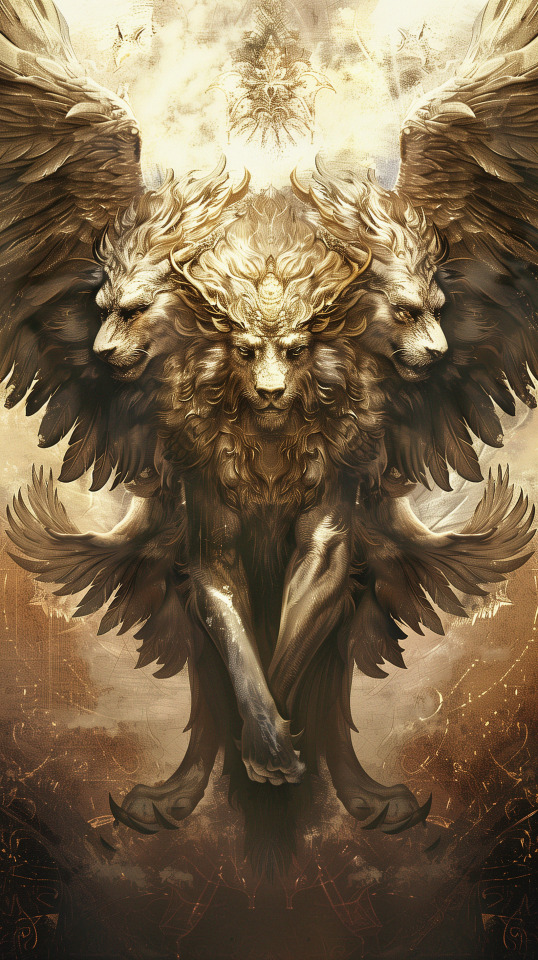
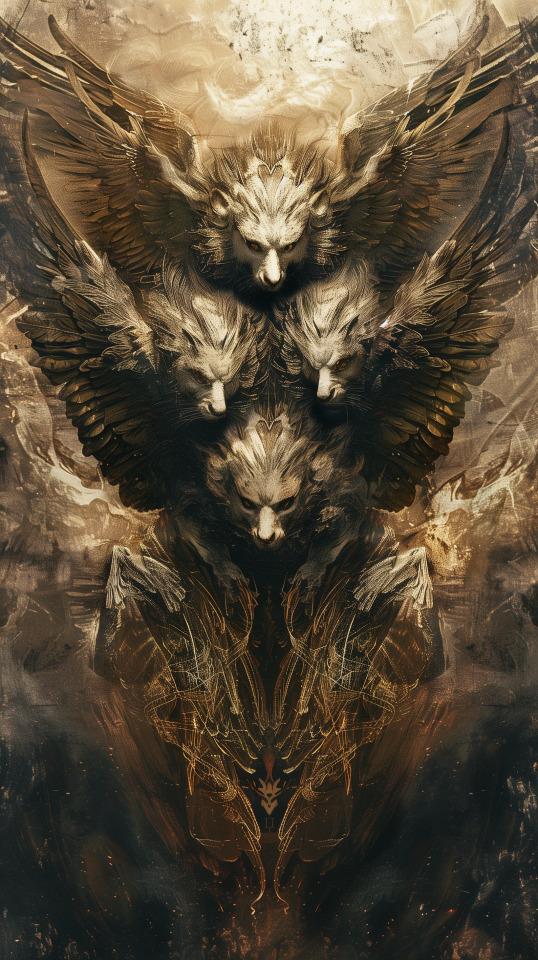
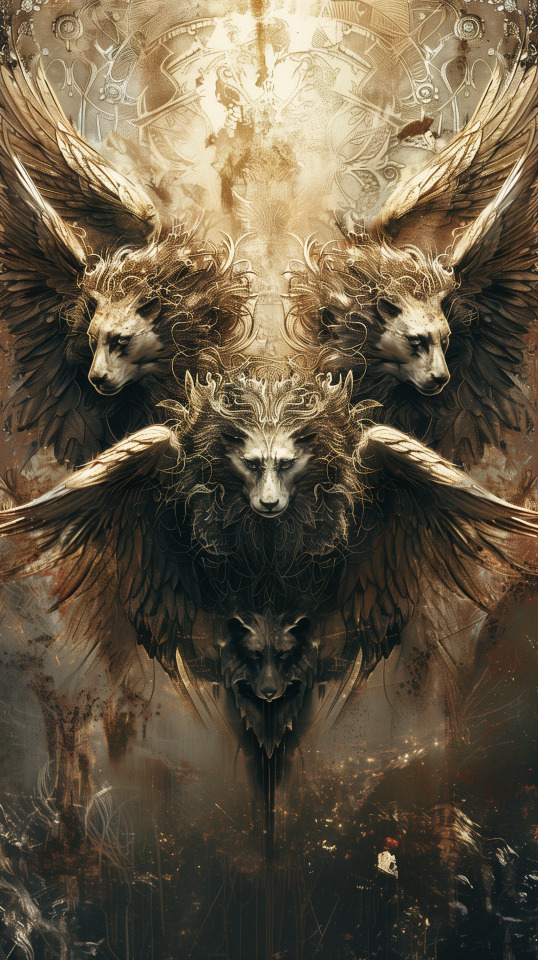
The Kerubim “the Strong Ones” Talon Abraxas The Kerubim can be conceived of as a reflection of the Four Holy Living Creatures of Kether, the powers of the Eternal Elements. The duty of the Chayoth ha-Qodesh is to formulate the primary pattern upon which the rest of existence is built. These Kerubic forces descend the Middle Pillar to Yesod where the Kerubim, as the structural powers of the Universe, support this existence. Therefore, the Kerubim are the formative powers of the Elements stationed in the sphere of Yesod, the etheric substructure that supports the physical universe. As these etheric powers, the Kerubim are the formative forces of the world and humankind. As Angels of Lunar Yesod, the Kerubim also have an association with time, the four Kerubic points in the year which are the Hermetic Qabalah’s cross quarter days. Their name means “the Strong Ones” which is derived from the Akkadian word Karibu which means “one who prays” or “one who intercedes.”
The work of the Kerubim is to influence communication between the inner and outer worlds by serving as Guardians, Heralds, Equilibrators and Guides. They work on the building of knowledge and the harnessing of force in etheric or Yesodic methods. One of these methods is the use of symbols relating to Yesodic perception within the depths of the unconscious mind. With the progression of time, these symbols become less ritualistic and more psychic, becoming tools in the hands of the aspirant. These images are the contents of the Treasure House of Images, and the forces behind these images are the Angels of Yesod.
The Tetradic Kerubim are the animated powers of YHVH working through the fixed signs of the Zodiac. As given in Exodus 25:18-19 and 37:9, their shapes represent the aspects of the four dynamics of the Elements. These energies are not the Elements themselves, but rather are placed between the Angels and the Elements in hierarchy. One of the functions of the Kerubim is to take these energies and set them into motion and as such,, this Choir of Angels has a direct affect on the Earth and Man. As presidents of the Elemental Forces, these Four Kerubim are each assigned one of the letters of the Divine Name YHVH, and they operate in and through the four astral Elements in Yesod before these Elements are formulated in the physical world of Malkuth.
This Tetrad serves as Equilibrators by creating a stable nucleus from which the physical world comes forth into being. These four Vice-Gerants of the Elements, under the Presidency of Spirit (Gabriel), are synthesized in the formula of YHSHVH. Yod, Lion, Nequaquam Vacuum, Nowhere a Void; He, Eagle, Libertas Evangelii, Liberty of the Gospel; Vau, Man, Dei Intacta Gloria, Unsullied Glory of God; and Heh (f), Ox, Legis Jugum, Yoke of the law; and in the midst of the four letters is Shin, the letter of Spirit, which, formed from the Tetragrammaton, gives the Divine name of Yeheshua, The Pentagram represents the concentrated force of the Spirit and the four Elements governed by the five letters of the Name of the Restorer, YHSHVH and is not only attributed to the planet Mars, but also shows the Kerubim and the Wheel of Spirit. The Kerubim of Ezekiel have four faces, those of the Lion, the Bull, the Man and the Eagle, alternating with each other by rotation. Beside them was the symbolic form of the Spirit, symbolized by the wheel. As suggested by the two wings that covered their bodies and the two wings that stretched upwards to each other, the synthesis of the Kerubim is found in the revolving Cross, in the Pentagram, and in the idea Spirit dominating the four Elements.
The Kerubim are winged celestial beings which, unlike most conceptions of angels as anthropomorphic, are zoomorphic. On the 32nd Path between Malkuth and Yesod, the Zelator encounters these Four Kerubim who perform elemental purifications which aid in the alchemical transformation of the aspirant. In this ritual, the aspirant learns that the Elemental Spirits are invoked through the power and governance of the Kerubim and their Zodiacal symbols. They are given Hebrew names but their appearance is primarily Egyptian:
Adam (Hebrew for Man), Kerub of Air, stationed in the East, human-headed Aquarius. “The Priest with the Mask of Osiris spake and said, ‘Thou canst not pass the Gate of the Eastern Heaven unless thou canst tell me my name’.” of which is replied “Thou art NUT, Goddess of the Firmament of Air. Thou art HORMAKU, Lord of the Eastern Sun.”
Aryeh (Hebrew for Lion), Kerub of Fire, stationed in the South, Lion-headed Leo. “The Priest with the mask of the Lion spake and said, ‘Thou canst not pass the Gate of the Southern Heaven unless thou canst tell me my name’.” Of which is replied, “Thou art MAU the Lion, Very Powerful Lord of Fire. Thou art RA, the Sun in his strength.”
Nesher (Hebrew meaning Eagle), Kerub of Water, stationed in the West, Eagle-headed Scorpio. “The Priest with the mask of the Eagle spake and said, “Thou canst not pass the Gate of the Western Heaven unless thou canst tell me my name’.” of which is replied “HEKA, Mistress of HESUR, Ruler of Water, is Thy name. Thou art TOUM, the Setting Sun.”
Shor (Hebrew meaning Bull), Kerub of Earth, stationed in the North, Bull-headed Taurus. “The Priest with the mask of the Ox spake and said ‘Thou canst not pass the Gate of the Northern Heaven unless thou canst tell me my name’.” of which is responded, “SATEM, in the abode of SHU, the Bull of Earth, is Thy name. Thou art KEPHRA, the Sun at Night.”
The arrangement of the Theoricus Hall of only four officers suggests the conciliatory Element of Air reconciling the opposing energies within the Hall, resulting in a perfect balance of forces. The number four is associated with Chesed, the first Sephirah to manifest below the Abyss, but it also refers to Yesod as the firm foundation within which the Four Elements are given etheric form which then later materialize in Malkuth during the course of the Lightning Flash.
In the Theoricus Ritual, as the Hierophant addresses the candidate on the meaning of the Cross within the Triangle, it is stated that the Cross, placed upon the Altar at the base of the Tree of Life, refers to the Four Rivers of Paradise. It is Gabriel who rules the “Living Water streams that well from out the Highest Throne.” “…And he showed me a pure river of the water of life, clear as crystal, proceeding out of the throne of God and of the Lamb.” (Revelations 22:1). These Rivers are referred to in Genesis 2:10-14: “And a River, Nahar, went forth out of Eden to water the Garden, and from thence it was parted and come into four heads. And the name of the First River is Pison, it is that which compasseth the whole land of Havilah, where there is gold. And the gold of that land is good. There is Bdellium and the Onyx stone. [–Leo.] And the name of the Second River is Gihom, the same as that which compasseth the whole land of Ethiopia. [–Scorpio.] And the Name of the Third River is Hiddekel, that is it which goeth forth to the East of Assyria. [–Aquarius.] And the Fourth River is Euphrates. [–Taurus.]” This indicates the Presidency of Spirit (Gabriel) over the four Elements.
In the Zelator Ritual the aspirant is told. “And Tetragrammaton placed Kerubim at the East of the Garden of Eden and a Flaming Sword which turned every way to keep the Path of the Tree of Life, for He has created Nature that Man, being cast out of Eden, may not fall into the Void. He has bound Man with the Stars, as with a chain. He allures him with scattered fragments of the Divine Body in bird and beast and flower, and He laments over him in the Wind and the Sea and in the Birds. When the times are ended, He will call the Kerubim from the East of the Garden, and all shall be consumed and become Infinite and Holy.” …. “This drawing of the Flaming Sword of the Kerubim is a representation of the Guardians of the Gates of Eden.
As the Qabalah teaches, the everlasting abode of the Higher Self is in the Eden of Paradise, the supernal sanctuary which is forever guarded from chaos by the Flaming Sword of the Kerubim whirling across borders of the Abyss. After the descent from Grace, the Kerubim were stationed at the Abyss to separate the Supernals from the effects of the Fall.
The Four Kerubim, through their assignation to the four Archangels, are Four of the Seven in the Presence of the Lord. This description of the Kerubim is from John’s vision (Revelations 4:7-8): “And the first beast was like a lion, and the second beast like a calf and the third beast had a face as a man, and the fourth beast was like a flying eagle. And the four beasts had each of them six wings about him; and they were full of eyes within: and they rest not day and night saying, ‘Holy, Holy, Holy, Lord God Almighty, which was, is and is to come.’ ” Here, the Kerubim are seen as single-headed but having six wings, thus uniting the powers of the number seven (the Planets) with the number four (the Elements).
83 notes
·
View notes
Text
its substructure, dweller and curse
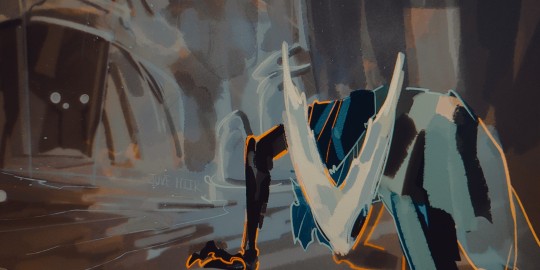
♪ лунный бард — метаморфоза
363 notes
·
View notes
Text
Just saying, writing about stuff and actually being okay with it/practicing it in real life are two different things.
For instance, I can write the most cruel, disgusting borderline masochist fanfic about a character but would never even think of partaking in any of the aforementioned activities in real life.
And that's the great thing about fanfiction and fiction in general. However, I know that this mindset is not common because people tend to read stuff that they fantasize about doing physically but there's usually a boundary where you don't cross.
A corroborating example can be the concept and community of BDSM, which is actually very harmful to women and substructured on male supremacy and degrading women, however I feel fine reading about my favorite character/s stuffing me raw with handcuffs on.
Would I let a real man do it to me in real life though? No.
#aot smut#smut#aot x reader#jjk smut#jjk x reader#jjk#haikyuu#geto suguru#gojo x reader#gojo smut#thoughts#my thoughts#feminism#bd/sm community#lgbtq community#writers on tumblr
69 notes
·
View notes
Note
so Rung is basically Primus but amnesiac right
What if he comes across one of Cybertron's reproductive systems, and not knowing why, felt an instinctual draw to "reunite" his body with it?
Imagine him just clambering onto one of the many cock-shaped stalagmites in the substructures of the planet, trying to rut against it. Only to lose his footing and fall valve-first onto the bulbous tip, spearing himself to the limit and making himself cum almost instantly.
Then the cave system, which are basically Primus' internal proto-components, and are still instinctively attuned to his being, detects his pleasure, and seeks to encourage it by pulsing and rocking against Rung's tight little pussy. Ttapping him in a continuous series of overloads as the planet just keeps reacting to his responses, as if desperately trying to breed himself. That reedy old man is gonna be stuck down there for a long time cumming his brains out without ever realising that he could've stopped the whole thing himself (or maybe he didn't want to, deep down. Primus has always been a massive whore after all)-🔌
hgrhh... Rung reuniting with his body... the planet is so happy to have the missing part of it close once again, that it can feel good again, that it can start to breed again...
93 notes
·
View notes
Note
Hi! I like your work and I saw one post a year ago in which some "Balrogs" were mentioned. Is it possible to get some information about them and their biology maybe? I'm asking here because I haven't found any information about them on all three of your accounts.
thanks! it's crazy that this keeps coming up even 10 years later LOL. the balrogs were the subject of literally one single post which contained the following information:
they are a "cousin species" to cherubs
their genders align with order (blue) and chaos (red) rather than creation and destruction
they transform into giant scorpions rather than giant snakes
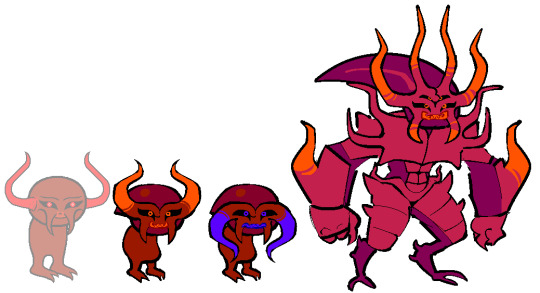

the post you saw on this blog is the second time in a decade i have ever drawn or talked about this concept so there is not a lot else to go around but because you asked nicely i drew some more pictures and thought about them a bit more:
instead of discarding a shared personality upon maturity, balrogs consume their mates and make them part of their body. they take on their final scorpion form together, with the losing partner becoming the tail (above). sort of like the male anglerfish who shrinks down to just a sexual organ attached to the female
cherubs are angels who fly through space so balrogs live in the cores of planets instead (duh)
cherubs are associated with black holes and astrophysics so balrogs are connected to quantum mechanics and the physics of tiny particles (where order / chaos and probability are important physical forces)
^ in connecting those two things, balrogs could have the ability to burrow not just into the earth but into the atomic substructure of all matter. so they can travel across the universe to meet and fight but through back channels rather than actually being able to fly through space
they use the Forge / other volcanoes to lay their eggs in the cores of planets and then the eggs hatch when the inhabitants of that planet dig deep enough to awaken them? like the story of the balrog in lord of the rings
the eggs would hatch into millions of babies like spider eggs and the swarm of young balrogs would spread across the planet to potentially disastrous effect. but only one or a few ultimately survive to grow into the cosmically powerful adult stage
i think the discovery of a balrog egg sac in the core of your planet could be like a kind of cosmic test determining whether the civilisation on that planet aligns more with the forces of order or chaos. and maybe the results of that test determine which type of balrog survives to adulthood
unless people have more questions i don't particularly have plans to do anything further with balrogs but you're not the only person who has expressed interest so i think it would be fun if anyone who is interested in the idea could play with it themselves and see what they come up with :)
#balrogil#fanspecies#has it really been more than a year since the last time someone asked though. christ
68 notes
·
View notes
Text
MIT chemists have developed a new way to synthesize complex molecules that were originally isolated from plants and could hold potential as antibiotics, analgesics, or cancer drugs. These compounds, known as oligocyclotryptamines, consist of multiple tricyclic substructures called cyclotryptamine, fused together by carbon–carbon bonds. Only small quantities of these compounds are naturally available, and synthesizing them in the lab has proven difficult. The MIT team came up with a way to add tryptamine-derived components to a molecule one at a time, in a way that allows the researchers to precisely assemble the rings and control the 3D orientation of each component as well as the final product.
Continue Reading.
101 notes
·
View notes